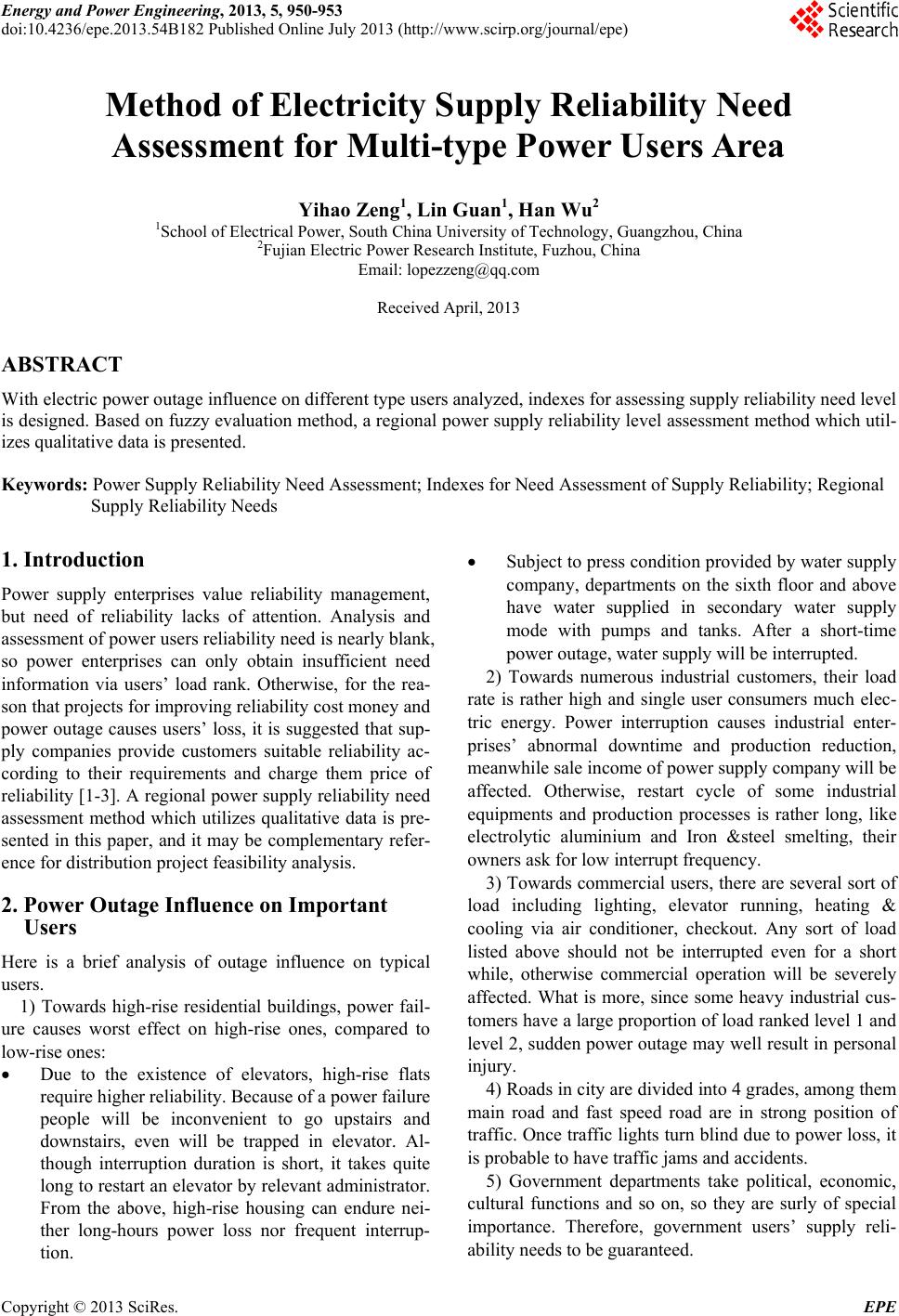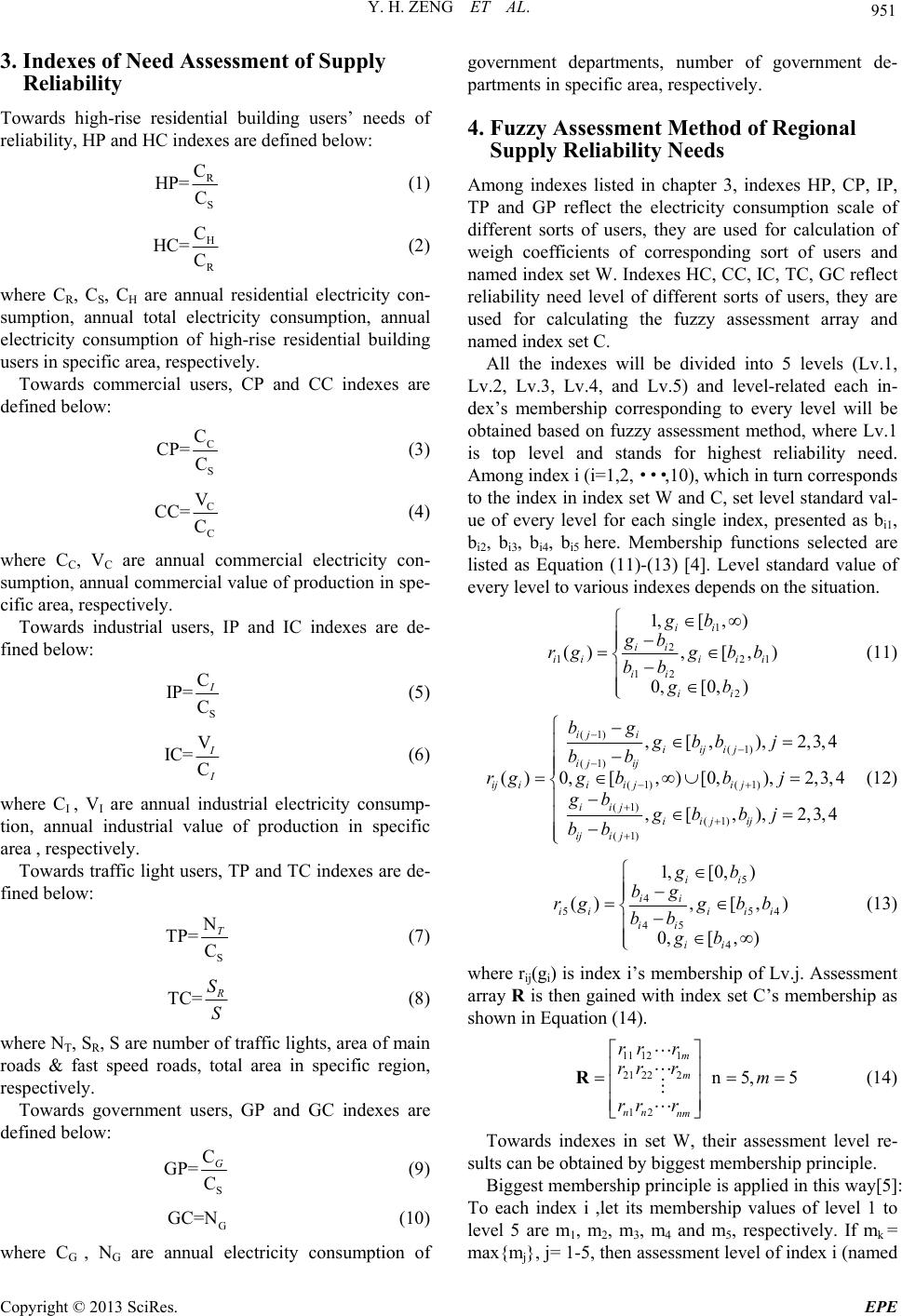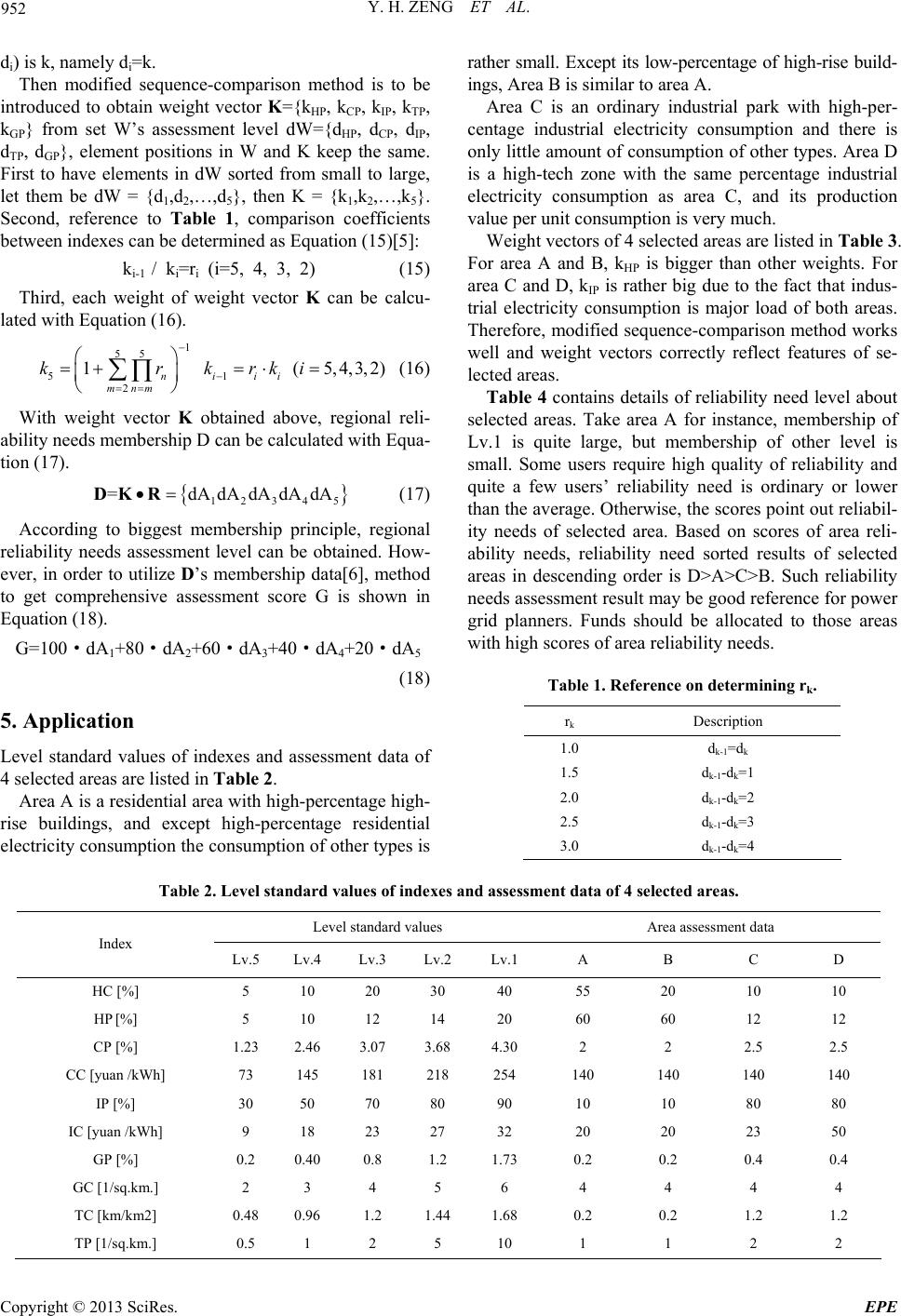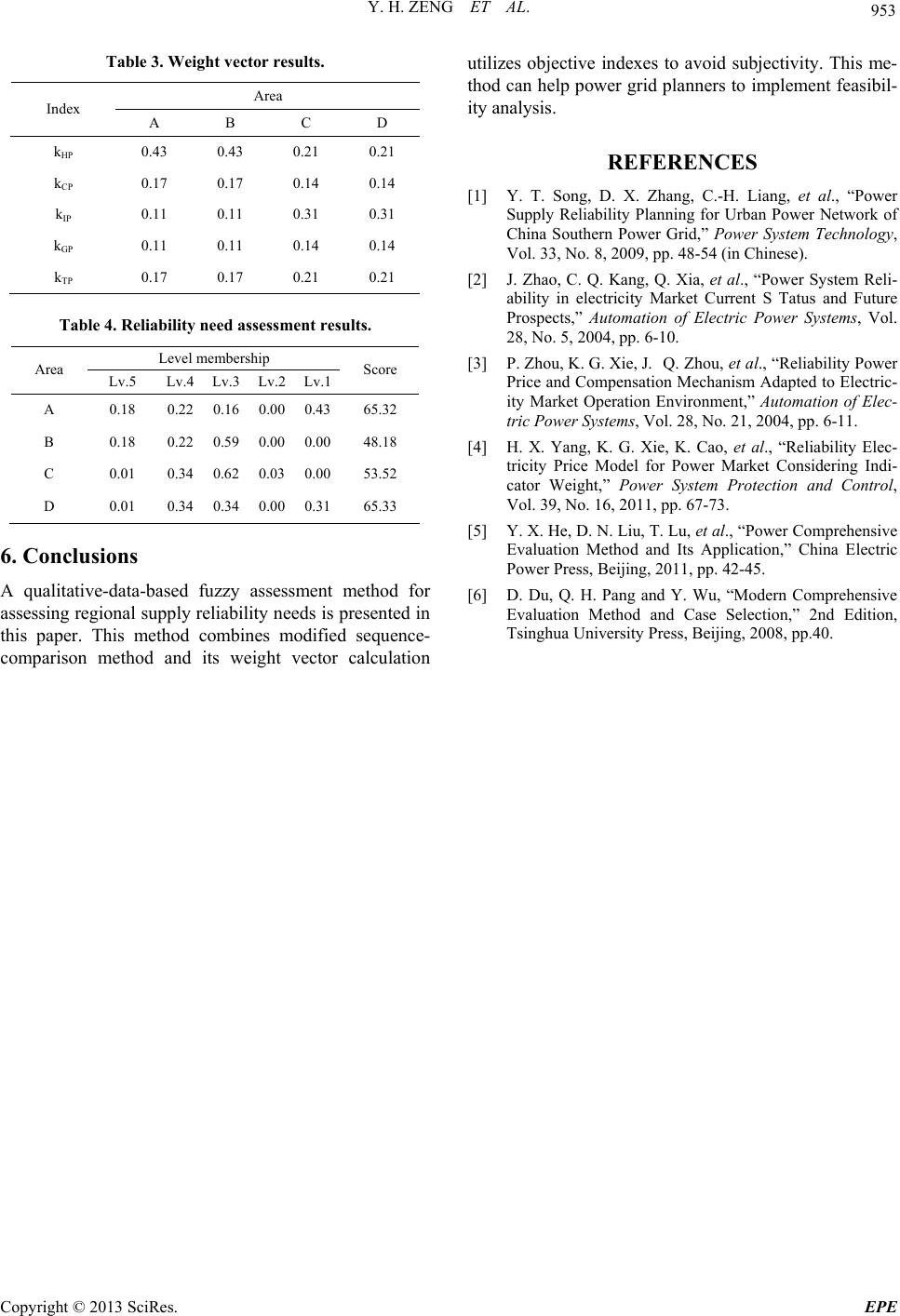Paper Menu >>
Journal Menu >>
 Energy and Power Engineering, 2013, 5, 950-953 doi:10.4236/epe.2013.54B182 Published Online July 2013 (http://www.scirp.org/journal/epe) Method of Electricity Supply Reliability Need Assessment for Multi-type Power Users Area Yihao Zeng1, Lin Guan1, Ha n Wu2 1School of Electrical Power, South China University of Technology, Guangzhou, China 2Fujian Electric Power Research Institute, Fuzhou, China Email: lopezzeng@qq.com Received April, 2013 ABSTRACT With electric power outage influ ence on different type users analyzed, indexes for assessing supply reliability need level is designed. Based on fuzzy ev aluation method, a regional power supply reliability lev el assessment method which util- izes qualitative data is presented. Keywords: Power Supply Reliability Need Assessment; Indexes for Need Assessment of Supply Reliability; Regional Supply Reliability Needs 1. Introduction Power supply enterprises value reliability management, but need of reliability lacks of attention. Analysis and assessment of power users reliability need is nearly blank, so power enterprises can only obtain insufficient need information via users’ load rank. Otherwise, for the rea- son that projects for improving reliability cost money and power outage causes users’ loss, it is suggested that sup- ply companies provide customers suitable reliability ac- cording to their requirements and charge them price of reliability [1-3]. A regional power supply reliab ility need assessment method which utilizes qualitative data is pre- sented in this paper, and it may be complementary refer- ence for distribution project feasibility analysis. 2. Power Outage Influence on Important Users Here is a brief analysis of outage influence on typical users. 1) Towards high-rise residential buildings, power fail- ure causes worst effect on high-rise ones, compared to low-rise ones: Due to the existence of elevators, high-rise flats require higher reliability. Because of a power failure people will be inconvenient to go upstairs and downstairs, even will be trapped in elevator. Al- though interruption duration is short, it takes quite long to restart an elevator by relevant administrator. From the above, high-rise housing can endure nei- ther long-hours power loss nor frequent interrup- tion. Subject to press conditio n provided by water supply company, departments on the sixth floor and above have water supplied in secondary water supply mode with pumps and tanks. After a short-time power outage, water supply will be interrupted. 2) Towards numerous industrial customers, their load rate is rather high and single user consumers much elec- tric energy. Power interruption causes industrial enter- prises’ abnormal downtime and production reduction, meanwhile sale income of power supply company will be affected. Otherwise, restart cycle of some industrial equipments and production processes is rather long, like electrolytic aluminium and Iron &steel smelting, their owners ask for low interrupt frequency. 3) Towards commercial users, there are several sort of load including lighting, elevator running, heating & cooling via air conditioner, checkout. Any sort of load listed above should not be interrupted even for a short while, otherwise commercial operation will be severely affected. What is more, since some heavy industrial cus- tomers have a large proportion of load ranked level 1 and level 2, sudden power outag e may well result in personal injury. 4) Roads in city are divided into 4 grades, among them main road and fast speed road are in strong position of traffic. Once traffic lights turn blind due to power loss, it is probable to have traffic jams and accidents. 5) Government departments take political, economic, cultural functions and so on, so they are surly of special importance. Therefore, government users’ supply reli- ability needs to be guaranteed. Copyright © 2013 SciRes. EPE  Y. H. ZENG ET AL. 951 3. Indexes of Need Assessment of Supply Reliability Towards high-rise residential building users’ needs of reliability, HP and HC indexes are defined below: R S C HP= C (1) H R C HC= C (2) where CR, CS, CH are annual residential electricity con- sumption, annual total electricity consumption, annual electricity consumption of high-rise residential building users in specific area, respectively. Towards commercial users, CP and CC indexes are defined below: C S C CP= C (3) C C V CC= C (4) where CC, VC are annual commercial electricity con- sumption, annual commercial value of produc tion in spe- cific area, respectively. Towards industrial users, IP and IC indexes are de- fined belo w: S C IP= C I (5) V IC= C I I (6) where CI , VI are annual industrial electricity consump- tion, annual industrial value of production in specific area , respectively. Towards traffic light users, TP and TC indexes are de- fined belo w: S N TP= CT (7) TC= R S S (8) where NT, SR, S are number of traffic lights, area of main roads & fast speed roads, total area in specific region, respectively. Towards government users, GP and GC indexes are defined below: S C GP= CG (9) G GC=N (10) government departments, number of government de- partments in specific area, respectively. where CG , NG are annual electricity consumption of 4. Fuzzy Assessment Method of Regional Am, indexes HP, CP, IP, ill be divided into 5 levels (Lv.1, Lv Supply Reliability Needs ong indexes listed in chapter 3 TP and GP reflect the electricity consumption scale of different sorts of users, they are used for calculation of weigh coefficients of corresponding sort of users and named index set W. Indexes HC, CC, IC, TC, GC reflect reliability need level of different sorts of users, they are used for calculating the fuzzy assessment array and named index set C. All the indexes w .2, Lv.3, Lv.4, and Lv.5) and level-related each in- dex’s membership corresponding to every level will be obtained based on fuzzy assessment method, where Lv.1 is top level and stands for highest reliability need. Among index i (i=1,2,···,10), which in turn corresponds to the index in index set W and C, set level standard val- ue of every level for each single index, presented as bi1, bi2, bi3, bi4, bi5 here. Membership functions selected are listed as Equation (11)-(13) [4]. Level standard value of every level to various indexes depends on the situation. 1 2 12 12 2 1 () , [,) 0,[0, ) ii ii iii ii ii ii gb rg g bb bb gb (11) 1,[, )gb (1) (1) (1) (1) (1) (1) (1) (1) ,[, ),2,3,4 ()0,[, )[0,),2,3,4 ,[ ,),2,3,4 iji iijij ij ij ij iiijij iij iijij iji j bg gbb j bb rgg bbj gb gb bj bb (12) 5 4 55 45 4 1,[0, ) (),[, ) 0,[, ) ii ii iii ii ii ii gb bg rgg bb bb gb 4 (13) where rij(g) is index i’s membership of Lv .j. Assessment i array R is then gained with index set C’s membership as shown in Equation (14). rr 1 11 12 21 222 12 n5, 5 m m nn nm r rr rm rr r R (14) Towards indexes in set W, their assessment level re- su : To lts can be obtained by biggest membership principle. Biggest membership principle is applied in this way[5] each index i ,let its membership values of level 1 to level 5 are m1, m2, m3, m4 and m5, respectively. If mk = max{mj}, j= 1-5, then assessment level of index i (named Copyright © 2013 SciRes. EPE  Y. H. ZENG ET AL. Copyright © 2013 SciRes. EPE 952 nce-comparison method is to be in Third, each w la (16) With weight vector K obtained above, regional reli- ab (17) According to biggest membership principle, re +80·dA2+6 0·dA3+40·dA4+20·dA5 5. Application es of indexes and assessment data of h-percentage high- ris di) is k, namely di=k. Then modified seque troduced to obtain weight vector K={kHP, kCP, kIP, kTP, kGP} from set W’s assessment level dW={dHP, dCP, dIP, dTP, dGP}, element positions in W and K keep the same. First to have elements in dW sorted from small to large, let them be dW = {d1,d2,…,d5}, then K = {k1,k2,…,k5}. Second, reference to Table 1, comparison coefficients between indexes can be determined as Equation (15)[5]: ki-1 / ki=ri (i=5, 4, 3, 2) (15) eight of weight vector K can be calcu- ted with Equation (16). 1 5 5 51 2 1 (5,4,3,2) niii mnm krkrki ility needs membership D can be calculated with Equa- tion (17) . 12345 = dAdAdAdAdADK R regional liability needs assessment level can be obtained. How- ever, in order to utilize D’s membership data[6], method to get comprehensive assessment score G is shown in Equation (18) . G=100·dA1 (18) Level standard valu 4 selected areas are listed in Table 2. Area A is a residential area with hig e buildings, and except high-percentage residential electricity consumption the consumption of other types is rather small. Except its low-percentage of high-rise build- ings, Area B is similar to area A. Area C is an ordinary industrial park with high-per- centage industrial electricity consumption and there is only little amount of consumption of other types. Area D is a high-tech zone with the same percentage industrial electricity consumption as area C, and its production value per unit consumption is very much. Weight vectors of 4 selected areas are listed in Table 3. For area A and B, kHP is bigger than other weights. For area C and D, kIP is rather big due to the fact that indus- trial electricity consumption is major load of both areas. Therefore, modified sequence-comparison method works well and weight vectors correctly reflect features of se- lected areas. Table 4 contains details of reliability need level about selected areas. Take area A for instance, membership of Lv.1 is quite large, but membership of other level is small. Some users require high quality of reliability and quite a few users’ reliability need is ordinary or lower than the average. Otherwise, the scores point out reliabil- ity needs of selected area. Based on scores of area reli- ability needs, reliability need sorted results of selected areas in descending order is D>A>C>B. Such reliability needs assessment result may be good reference for power grid planners. Funds should be allocated to those areas with high scores of area reliability needs. Table 1. Reference on determining rk. rk Description 1.0 dk-1=dk 1.5 dk-1-dk=1 2.0 dk-1-dk=2 2.5 dk-1-dk=3 3.0 dk-1-dk=4 Table 2. Level standard values of indexes and assessme nt data of 4 selected areas. Level standard values Area assessment data Index Lv.5 Lv.4 Lv.3 Lv.2 Lv.1 A B C D HC [%] 5 10 20 30 40 55 20 10 10 HP [%] 5 10 12 14 20 60 60 12 12 CP [%] 1. CC h] 140 140 IC [h] GC .] 0. 0.1. 1.1.0.1. 23 2.46 3.07 3.68 4.30 2 2 2.5 2.5 [yuan /kW73 145 181 218 254 140 140 IP [%] 30 50 70 80 90 10 10 80 80 yuan /kW9 18 23 2 7 32 20 20 23 50 GP [%] 0.2 0.40 0.8 1.2 1.73 0.2 0.2 0.4 0.4 [1/sq.km2 3 4 5 6 4 4 4 4 TC [km/km2] 48 96 2 44 68 2 0.2 2 1.2 TP [1/sq.km.] 0.5 1 2 5 10 1 1 2 2  Y. H. ZENG ET AL. 953 Weight v resu. Table 3.ectorlts Area Index A B C D kHP 0 0 0 0 .43.43.21.21 kCP 0.17 0.17 0.14 0.14 kIP 0.11 0.11 0.31 0.31 kGP 0.11 0.11 0.14 0.14 kTP 0.17 0.17 0.21 0.21 Rely neTable 4.iabilited assessment results. Lev e l members h i p Are Lv.5 .2 Lv.1 re a Sco Lv.4 Lv.3 Lv A 0.18 0.22 0.16 0.00 0.43 65.32 B 0.18 0.22 0.59 0.00 0.00 48.18 C 0.01 0.34 0.62 0.03 0.00 53.52 D 0.01 0.34 0.34 0.00 0.31 65.33 6. Conclusions ased fuzzy assessment method for utilizes objecti indexes to avoid suity. is me- REFERENCES [1] Y. T. Song, Dng, et al., “Power Supply Reliabilityetwork of and Future echanism Adapted to Electric- Indi- cation,” China Electric n,” 2nd Edition, A qualitative-data-b assessing regional supply reliability need s is presented in this paper. This method combines modified sequence- comparison method and its weight vector calculation thod can help power grid planners to implement feasibil- ity analysis. vebjectiv Th . X. Zhang, C.-H. Lia Planning for Urban Power N China Southern Power Grid,” Power System Technology, Vol. 33, No. 8, 2009, pp. 48-54 (in Chinese). [2] J. Zhao, C. Q. Kang, Q. Xia, et al., “Power System Reli- ability in electricity Market Current S Tatus Prospects,” Automation of Electric Power Systems, Vol. 28, No. 5, 2004, pp. 6-10. [3] P. Zhou, K. G. Xie, J. Q. Zhou, et al., “Reliability Power Price and Compensation M ity Market Operation Environment,” Automation of Elec- tric Power Systems, Vol. 28, No. 21, 2004, pp. 6-11. [4] H. X. Yang, K. G. Xie, K. Cao, et al., “Reliability Elec- tricity Price Model for Power Market Considering cator Weight,” Power System Protection and Control, Vol. 39, No. 16, 2011, pp. 67-73. [5] Y. X. He, D. N. Liu, T. Lu, et al., “Power Comprehensive Evaluation Method and Its Appli Power Press, Beijing, 2011, pp. 42-45. [6] D. Du, Q. H. Pang and Y. Wu, “Modern Comprehensive Evaluation Method and Case Selectio Tsinghua University Press, Beijing, 2008, pp.40. Copyright © 2013 SciRes. EPE |

